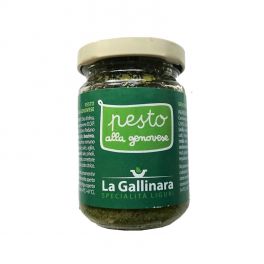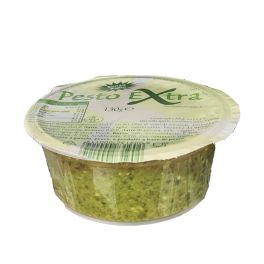Pesto alla Genovese: what it is, where to buy it online and how to use it in the kitchen
Pesto Genovese is one of the oldest recipes from Liguria and also one of the best known. This tasty and flavoursome sauce is a versatile product that can be used in the kitchen, as a condiment for pasta or as a base for other tasty recipes: sauces for crostini, a base for stuffed sandwiches or boiled meats.The primary characteristic of Ligurian pesto is its fragrance obtained, first of all, from Genoese Basil PDO, mixed with other ingredients of controlled origin, with an unmistakable flavour.
It is protected by the Consorzio del pesto genovese, with legal headquarters in Piazza Ferrari 1, Genoa and operational headquarters in Via Cavallotti 5Ar, Genoa.There are many variants of Ligurian pesto, the most famous of which is the one without garlic also sold in supermarkets; if you want to try the real pesto di Genova, you need to know where to buy it and which ingredients are regulated by the Consorzio.
Read this guide to recognise real Genoese pesto straight away!
How to make pesto genovese
The product specification for pesto di Genova indicates how it is made, in line with the traditional recipe of the region. Of fundamental importance are the ingredients, which give pesto its unmistakable organoleptic characteristics, which are also set out in the specification, together with the method of preservation.
Basilico Genovese DOP is the basic ingredient of pesto and its quantity must not be less than 25%. The first article of the specification attributes the name Pesto Genovese to the processing of PDO basil. It therefore delimits the processing of real pesto to the entire territory of the Liguria region.
The original Pesto di Genova recipe calls for the use of other ingredients such as:
- extra virgin olive oil
- Parmesan cheese DOP or Grana Padano and Pecorino DOP
- garlic
- pine nuts
- walnuts instead of pine nuts
- salt
All ingredients must have specific characteristics that attest to their quality.
First the basil must be washed and dried, taking care not to crush it.
The basil must then be pounded with a mortar or other equipment recognised by the promoting committee. To this must be added the other ingredients, ground until a homogeneous mixture is obtained in a short time, to avoid oxidation.
How do you make homemade pesto at home?
The basil must be PDO, otherwise the end result will not achieve the same fragrance as Genovese pesto. Basil for traditional pesto must have green leaves and be well dried. To pound the basil, it is recommended to use a mortar, in order to better preserve the flavour.
The oil to be used must be domestic, but to obtain an unmistakable flavour, Riviera Ligure oil is recommended.
The proportion of ingredients recommended on the official website of basilico genovese DOP is:
- Half a clove of Vessalico garlic
- One soup spoon of pine nuts
- Three teaspoons of Parmesan cheese, one teaspoon of pecorino or Fiore sardo cheese
- Three teaspoons of Riviera Ligure olive oil
- a pinch of salt
If you want to use a blender instead of a mortar, take care not to blend the ingredients, but to crush them. A tip is to add the oil at the end of the process, pouring it in a trickle. At the end, everything must be mixed to obtain a homogeneous sauce.
Preserving Ligurian Pesto
Genoese pesto can be stored in the refrigerator or frozen. For freezing, glass jars with suitable closures or plastic jars are recommended.
The jars should contain a maximum of two portions, to facilitate thawing and consumption within the day.
If you prefer to store pesto in the refrigerator, special containers should be used. The pesto should be covered with oil to prevent oxidation.
.
Pasta with pesto and other recipes
Pesto is widely used to season pasta. Typical pesto pasta dishes are trofie, lasagne and trenette.
Trofie are a type of pasta made from durum wheat flour and water, with a characteristic shape that comes from rubbing the pasta on the kneading trough to give it its typical shape. They originate mainly from the Ligurian Riviera, where they are called trofiette.
Preparing trofie with pesto is very simple, as it is only a matter of cooking the pasta to the right point, so that it does not burn, and then seasoning it with pesto and Parmesan to taste.
The recipes for pesto lasagne and trenette pasta with potatoes and green beans are a bit more complicated.
The recipe for lasagne al pesto has a layered procedure, similar to that of lasagne alla Bolognese; the difference being that the red sauce is replaced with Ligurian pesto. For the rest, béchamel sauce is used and the surface is sprinkled with Parmesan cheese as in the Bolognese recipe.
Trenette, on the other hand, is a typical Ligurian pasta, very similar to linguine. The ingredients are typical of egg pasta: eggs, flour, water and salt.
Trenette is the most typical recipe for pesto pasta, together with trofie.
The classic recipe calls for boiling potatoes and green beans, in proportion to the pasta (for 600 g trenette, about 4 medium-sized potatoes and a dozen green beans).
The vegetables can be boiled directly in the water that will be used to cook the pasta. The trenette should only be poured in when the vegetables are cooked, as the cooking time does not exceed 3 minutes.
Once the pasta is cooked, the pesto, diluted with a tablespoon of water, must be added.
Where to buy pesto online!
If you want to be sure to buy some excellent Ligurian pesto, have a look at our store; you will find only typical Genoese pesto at advantageous prices.
Your purchase will be delivered within 3 days of your order!


 Italiano (IT)
Italiano (IT)  Deutsch (DE)
Deutsch (DE)  Français (FR)
Français (FR)  Español (ES)
Español (ES)  Polish (PL)
Polish (PL) 



Share on: